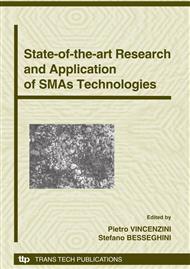p.41
p.47
p.57
p.63
p.69
p.77
p.86
p.92
p.101
Texture Development in Ni-Ti Thin Films
Abstract:
The Shape Memory Effect on Ni-Ti thin films is strongly dependent on several factors: (i) chemical composition of the matrix, (ii) presence of precipitates and (iii) preferential orientation. Ni-Ti alloys derive their unique nonlinear and anisotropic mechanical behavior from stress-induced martensitic transformations, where the resulting strains are affected by crystallographic orientation. The influence of the texture on the transformation characteristics of Ni-Ti thin films is discussed on the basis of models and experimental results of the literature. A brief review of the texture build-up on thin films obtained by different fabrication techniques (sputtering, melt spinning, diffusion treatment of ultra-fine laminates, …) is presented. Details about in situ techniques allowing the identification of the preferential orientation during the fabrication process are presented. The processing parameters that more strongly influence the preferential orientation of the Ni-Ti thin films are identified. The mechanisms for the different microstructures are summarized and a special emphasis is put on the type of preferential orientation and its evolution along the processing time.
Info:
Periodical:
Pages:
69-76
Citation:
Online since:
September 2008
Keywords:
Price:
Сopyright:
© 2008 Trans Tech Publications Ltd. All Rights Reserved
Share:
Citation:


